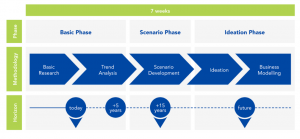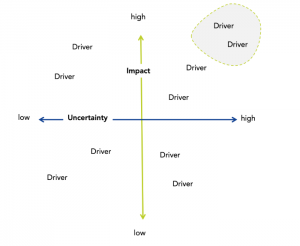Trend Seminar: Parenttech And The Future of Parenting
By Adina Görres
Published on 18 Nov 2019

In the past seven weeks, 25 newly appointed CDTM students engaged in intensive trend research. We sought to find out what parenting will look like in the future and how technology can act as an enabler in the process. During the first course of our CDTM journey, the Trend Seminar, we kicked off trend research by identifying drivers and essential challenges that parents face today. We then took a step further and investigated how these will develop in the future. Our class was tasked with ideating creative scenarios and even more ambitious business ideas to tackle some of the identified issues. The results were highly diverse, ranging from improvement to complete outsourcing of parental tasks.
Together with this fall’s project partner, the better ventures Group, our class collected current trends in parenting and developed actionable solutions within the realm of ‘parenttech’. This term was recently coined by the company and describes the growing interest in tech-driven solutions that change parenting for the better.
 CDTM Trend Seminar: Overview of the research phases[/caption]
CDTM Trend Seminar: Overview of the research phases[/caption]
 Driver Matrix in Trend Research[/caption]
Driver Matrix in Trend Research[/caption]
In the world of 2039, will children be a luxury good? Will it be robots that take care of feeding, educating and parenting our future generations?
The Trend Seminar is structured into three core phases: basic, scenario and ideation phase. Each phase is dedicated to specific exercises within trend research, challenging students to move beyond their comfort zone while learning what it takes to deal with uncertainty. During the basic phase, students dissect the research topic at hand, investigating and analysing it in regard to five categories: economy, society & the environment, technology, business, government & law. Students research trends within those categories and related them back to the research topic to create a comprehensive overview as a starting point for the next phase. The scenario phase builds on the trends identified in the basic phase and takes those to an extreme. What will parenting look like in 2039? This is what students asked themselves to truly open up their minds and consider scenarios beyond their imagination. In some ways the scenario phase is a thought exercise that forces students to loosen their scientific grip and get creative. This is especially valuable as a preparation tool for the ideation phase which is centered around the development of innovative solutions.Trend Research in Three Steps
After four weeks of researching, challenging and constructing scenarios, students reach the ideation phase. The final phase of the Trend Seminar is a practical application of the information students gather up to that point. The goal is to come up with business ideas and the respective business model that takes future trends and scenarios into account. A full overview of the seminar can be seen below. [caption id="attachment_15477" align="alignnone" width="848"] CDTM Trend Seminar: Overview of the research phases[/caption]
CDTM Trend Seminar: Overview of the research phases[/caption]
Trend Research with the better ventures group
better is a venture building company with the mission to enhance the quality of people‘s lives with simple, honest and beautiful experiences. The company’s key driver is the aim to create better experiences: be it better businesses, providing better services or living a better way. When better’s founders, Christoph and Jennifer Behn, thought about where to invest next, they didn't have to think long. Since the founding of their first venture, Die Kartenmacherei, 9 years ago, their company’s largest target group had been parents. As parents themselves, they were well aware of the challenges parents face. They were intrigued and coined the term ‘parent-tech’.So, how did we kick off our research?
At the beginning, it’s all quite overwhelming. Who are the parents of the future? What will their lives look like? How can we infer their interest by investigating the parents of today? Luckily, a number of expert lectures as well as internal CDTM resources made the trend research process a lot more manageable. To get a feel for the target group, students engaged with industry experts and stakeholders who shared their knowledge. Since parenting is highly fragmented in terms of opinions and methods, yet extremely popular, it was very valuable to get diversified insights. Expert lectures included entrepreneurs in the parenting realm, consultants as well as childcare specialists. The access to qualified information equipped students with a good understanding of the needs and challenges parents have. As the name suggests, trend research is an active process. Aside from traditional desk research, the student teams also took to the streets to meet their target group face-to-face. This was done in the context of childcare facilities and even playgrounds around Munich. Meeting parents and learning about their pain points really fueled the students’ ambition to find ways of easing the pressure many of them feel in their routine.How did we decide which key drivers to focus on?
After having analysed 25 different trends which have a significant impact on parenting within the next five years, the Class of Fall’19 identified the key forces that are driving those trends. Now after collecting the key drivers we go 20 years into the future and ask ourselves: What will most influence how our identified drivers will play out? To answer this question, we created a scenario matrix that gave us a glimpse into the future. This scenario matrix is spanned by two key drivers, that can be identified through the drivers matrix as shown below. Here we evaluated each driver with regards to its impact on parenting and its level of uncertainty. For instance, if a driver has a high impact on parenting and its outcome is highly certain, then the driver is placed in the second quadrant. However, we were interested in the first quadrant; drivers that have a high impact and a high uncertainty. [caption id="attachment_15478" align="alignnone" width="507"] Driver Matrix in Trend Research[/caption]
Driver Matrix in Trend Research[/caption]